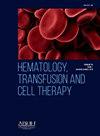COEXISTENCE OF BREAST CANCER AND MANTLE CELL LYMPHOMA
IF 1.8
Q3 HEMATOLOGY
引用次数: 0
Abstract
İntroduction
Patients cured of any cancer have an increased risk of developing a new primary malignancy compared to the general population. However, synchronous presentation of two tumours is a very rare condition. Here we aim to review the treatment approach of a case of synchronous mantle cell lymphoma and invasive ductal carcinoma of the breast.
Case Report
A 64-year-old woman presented with a right breast mass. Physical examination revealed a 3cm diameter mass lesion in the right breast and lymphadenopathy in the right axilla. Her past medical history was unremarkable except hypertension. In her family history, there was a history of breast cancer in her niece. Breast ultrasonography revealed 3 centimetres (cm) of malignant breast and multiple lymph nodes with thick cortex in bilateral axillae with indistinguishable fatty hilus. Tru-cut biopsy was performed for the mass in the breast and bilateral axilla lymph nodes. The breast biopsy was compatible with invasive ductal carcinoma with ER 90%, PR 10%, her2 negative and Ki67 proliferation index 10%. Bilateral axilla lymph node biopsy was reported as mantle cell lymphoma and immunohistochemically CD20: Positive, CD5: Positive, Cyclin D1: Positive, CD23: Negative, Lef1: Negative, Keratin: Negative, Ki67 proliferation index 25-30%. PET-CT revealed a mass in the right breast, lymph nodes with pathological appearance in the axillae, various lymph node stations in the abdomen and inguinal areas, and diffuse involvement suggestive of lymphoma infiltration in the right lung. Bone marrow aspiration/biopsy revealed mantle cell lymphoma involvement. The patient was discussed in the multidisciplinary tumour council and right axillary lymph node dissection was performed for staging. 5 lymph nodes showed ductal carcinoma metastasis and the rest of the lymph nodes showed mantle cell lymphoma involvement. Stage IV MHL and hormone positive IDC (T2N2) were detected and R-CHOP treatment was applied. PET-CT performed after three cycles of treatment showed complete response. The patient was discussed again in the multidisciplinary tumour council and surgical treatment for the breast was planned after completing 6 cycles of R-CHOP treatment. After treatment, the patient underwent modified radical mastectomy and the pathological stage was T3N3. After adjuvant RT, endocrine therapy was started and the patient is being followed in remission.
Conclusion
Coexistence of breast cancer and mantle cell lymphoma is a rare condition. In the few cases reported in the literature, treatment planning was made by considering the stage and treatment priority of both diseases. We planned to prioritise the treatment of lymphoma because our patient had stage 4 mantle cell lymphoma.
求助全文
约1分钟内获得全文
求助全文
来源期刊

Hematology, Transfusion and Cell Therapy
Multiple-
CiteScore
2.40
自引率
4.80%
发文量
1419
审稿时长
30 weeks
 求助内容:
求助内容: 应助结果提醒方式:
应助结果提醒方式:


